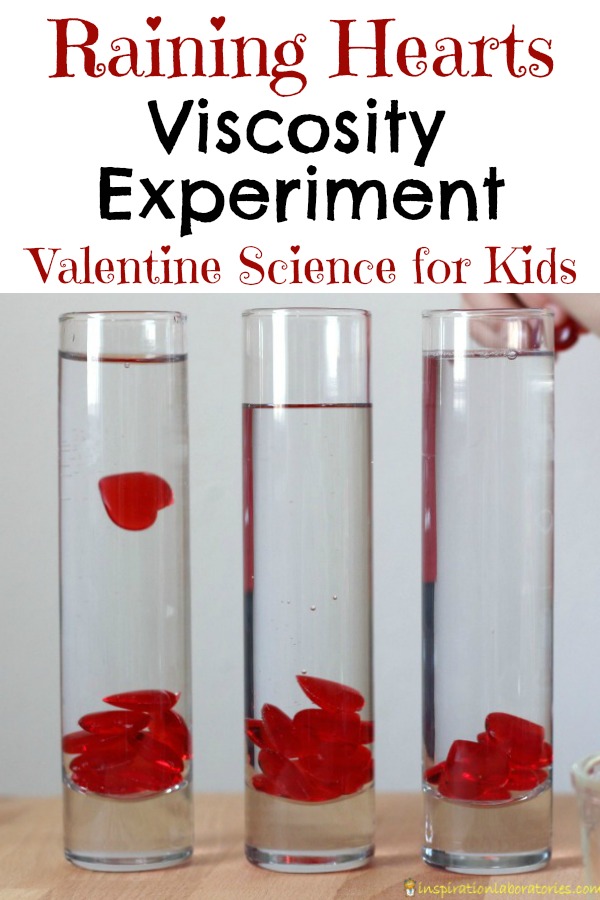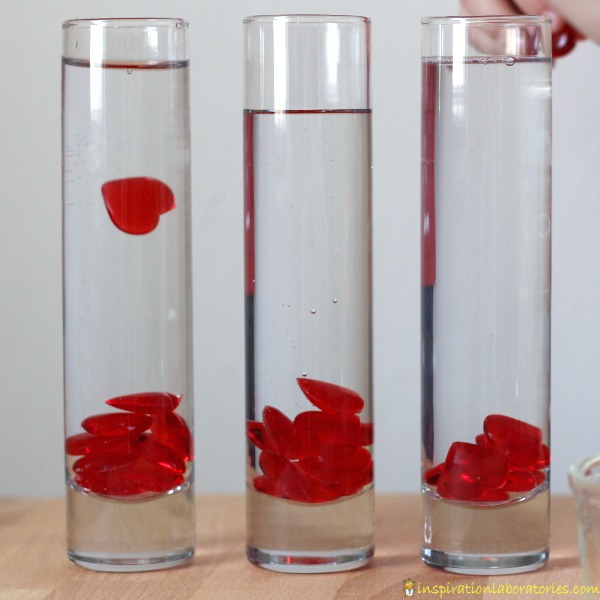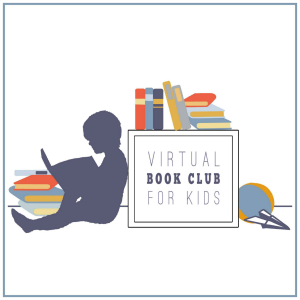Raining Hearts Viscosity Experiment
The Virtual Book Club for Kids is featuring The Day it Rained Hearts by Felicia Bond. We conducted a raining hearts viscosity experiment to go along with the book. This easy science exploration gets kids making predictions and thinking about the difference between liquids. Be sure to check out all of the love themed activities at the end of the post. Affiliate links are included in this post.

The Day it Rained Hearts by Felicia Bond
The Day It Rained Hearts is a sweet story about a little girl name Cornelia Augusta. On the day it rained hearts, Cornelia Augusta catches some. She turns each heart into a valentine for a special friend. Each of her heart valentines represents the animal in some way. Dog gets a collar made of hearts. Mouse gets a heart that looks like Swiss cheese. My kids enjoy seeing all of the hearts that Cornelia Augusta creates. Reading the story always inspires us to make our own valentines.
Raining Hearts Viscosity Experiment
I wanted to create a science activity with the raining heart theme. Dropping hearts into different liquids fits the idea nicely.
Supplies Needed:
- Bud vases or tall glasses
- Plastic hearts
- Water
- Mineral oil
- Clear soap
Add a different clear liquid to each vase. I filled one with water and a second with mineral oil. To the third vase, I added about three quarters water and one quarter clear soap and mixed it up. Let the three liquids settle and remove any soap bubbles from the top.

Make a prediction. Will there be a difference between the liquids? Will the hearts rain down at the same speed?
Drop hearts into each of the vases. Watch how they fall. For more accurate results, time how long the hearts take to fall. In which liquid do they fall the fastest?

Talk to your child about the difference in the liquids. Introduce the word viscosity. Viscosity is a measure of how a fluid flows. A more viscous liquid (one with a higher viscosity) is thicker and harder to flow. Use ketchup as an example. It moves out of its bottle slowly – it’s thick and viscous. Water has a low viscosity. It moves freely and easily.
Which of our liquids (water, mineral oil, or soap/water) was the most viscous? How do you know?
Watch the video of our viscosity experiment.
I did this viscosity experiment with Lily (almost 3) and Aiden (age 7). I worked more on the vocabulary and concepts with Aiden, but it was also important to let Lily be involved, too. While she dropped hearts and watched them fall, she was also forming ideas and laying a foundation for future learning.
Also check out our Raining Hearts Word Game. It’s a fun way to practice reading words while jumping around.
More Activities from the Virtual Book Club for Kids

See more love themed activities inspired by The Day It Rained Hearts:
How to Make a Simple Matching Game for Preschoolers – Mama Smiles
Raining Hearts Name Craft – Still Playing School
Broken Hearts Number Bonds – Rainy Day Mum
Love Heart Number Line – Adventures and Play
Valentine’s Counting Activity – Clare’s Little Tots
Hearts Sensory Bin – The Moments at Home
Easy Heart Shaped Pancakes -The Educators’ Spin On It
Preschool STEM: Valentine’s Tower – Preschool Powol Packets
Coding for Kids – The Day It Rained Hearts
Prewriting Valentine’s Day pack – Kori at Home
Throw a Love Fest | Kindness Party for Kids – Toddler Approved
The Day It Rained Hearts Process Art – Artsy Momma
Easy Heart Art Painting – Messy Little Monster
Also stop by the Virtual Book Club for Kids Facebook page to see what others are sharing!
Subscribe to the Inspiration Laboratories newsletter. Each issue has exclusive hands-on science explorations for children, a recap of our latest activities, and special resources selected just for you!
![]()



Leave a Reply